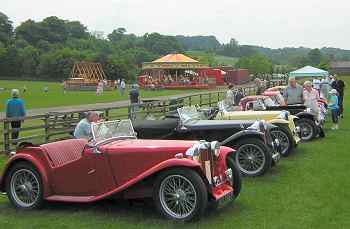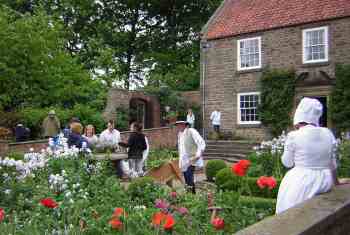40 Years of Beamish
2010 marked 40 years since the birth of Beamish and founder Director Dr. Frank Atkinson helped cut the cake to celebrate this special occasion. He is seen here with Richard Evans the current Director.
Westoe Netty Re-opens at Beamish
A chain pulling ceremony marked the opening of this addition at Beamish, The Westoe Netty, on Friday, 25th July 2008. South Shields artist Bob Olley and John Cuthbert, Managing Director of Northumbrian Water each ‘pulled the chain’ to draw curtains and declare the Netty open (though not for business !).
The Westoe Netty, a late nineteenth century public gentlemen’s toilet from Westoe in South Shields, was built around 1890. Although entirely unspectacular in itself, the Netty inspired a well known painting of the same name by Robert Olley.
Through its inclusion in Robert’s painting, the Netty has become a notable, cultural symbol of North East England’s working class. Many thousands of prints of the original painting have been sold to North Easterners and visitors to the region alike.
Originally the Westoe Netty was recessed into the embankment of the Harton Coal Company railway to Westoe Colliery, adjacent to the abutment carrying the railway bridge through Westoe. It was taken down by an enthusiastic group of Robert’s friends, in advance of demolition for regeneration in Westoe around 1996.
The Netty was stored in a shipyard in Hebburn in South Tyneside until 2007, when it was donated to Beamish by South Tyneside Council. It has now been rebuilt near to the Museum’s 1913 Railway Station, placing it in as near its original context as possible. It is open to visitors, though as an exhibit rather than serving its original purpose !
The MG Car Club Meet.

Photo: Beamish Museum visitors enjoying the site of the splendid MG cars on Sunday, 3rd June. The cars came from throughout the North to gather at Beamish for this Rally. The show was open to all MG models - on display were fine examples of the MG T series, MGAs, MGBs and MG Magnettes, dating from the 1930s to the 1980s.
.The Georgian Garden at Beamish.

Photo: The Georgian Garden on Sunday, 27th May 2007. There were guided talks and walks around the beautiful Georgian gardens at Pockerley Manor. Visitors enjoyed meeting the experts and exploring the formal parterre (a level space in a garden occupied by an ornamental arrangement of flower beds) and vegetable gardens and the orchard.
.Question: Was the fuel different in those early days?
A Motorcycle question in the email tray.
"Hello,
a friend of mine recently rebuilt a AJS.
He has overheating problem and assumes it to be a fuel problem.
Was the fuel different in those days?
Can one add something to the modern fuel to make it behave like the old
stuff?
Thanking you
Henning Schumacher"
Reply from Robert:
The problem is more likely to be retarded engine timing. Set the magneto lever to full retard position and adjust magneto points to just open at TDC (top dead centre).
Try the engine at this setting and readjust as necessary for better power when running.
Always start engine with lever at full retard and run as near full advance position as the engine will take. Adjust lever position for best running whilst travelling.
You could also try a bigger carburettor main jet.
I doubt that any additive will help.
Robert (18th June 2007)
A Couple of Stories from Past Newsletters.
I found these pieces in a 2004 Newsletter that may be of interest to new readers.
1. Beamish is Home to Ghostly Guests.
There are so many delightful old buildings among the 300 acres of the award-winning
Beamish Museum it would be something of a surprise if there weren't a few ghosts scattered among them.
In fact, the museum has at least three resident spooks who share the attraction with the
thousands of tourists who visit each year.
The best-known of them is The Grey Lady - a love-lorn spectre who haunts Starling Bridge, outside Beamish Hall and has been seen half a dozen times in recent years. According to the legend, the lady in question was the daughter of the then owner of Pockerley Manor and had fallen hopelessly in love with the son of the family who owned the Hall, once the home of the famous Shafto family.
Both families frowned on the match and they were prevented from seeing each other according to one version of the story she was even locked away in the cellar to prevent her from seeing him. "Several people have seen the ghostly figure of a lady in the mist," said the Museum's John Gall.
"They were thwarted in love and consequently she haunts the bridge waiting for her love to come, although in my experience it does seem she is seen by people who have been spending time at the Golf Club, The Back Horse, The Shepherd and Shepherdess or one of the other wonderful pubs we have round here."
The same could well be said of the ghost which haunts The Sun Inn, the old pub which stands in the museum's 1913 town street.
During the 1970s, the pub was dismantled stone by stone from its original home in High
Bondgate, Bishop Auckland, and moved to Beamish to stand alongside the shops, bank, tea
rooms and dentist to perfectly recreate an Edwardian town street.
But it appears that along with the cellars and stables, the Museum has brought a spirit- many visitors have reported feeling a presence in the pub's back rooms. The pub, previously known as The Tiger Inn, dates back at least as far as 1806 and interestingly includes among its former regulars the infamous serial killer Mary Ann Cotton, who was hanged in 1873 for poisoning her stepson and was suspected of carrying out 15 murders in all.
Even Home Farm. - the 1913 farmstead complete with old breeds of shorthorn cattle, saddleback pigs and Cheviot sheep - is reputedly haunted, by a basket. When work was being carried out to renovate the derelict buildings back in 1970, workmen discovered an old basket wedged between the joists in the kitchens. The basket was moved but when the men returned the following day, it had moved back into its original position.
These ghostly goings-on continued every night for several weeks without fail before the basket eventually gave up the fight and stayed put.
Home Farm is one of several buildings in the immediate area where charms have been discovered to protect the owners against witches, in this case a stone with a natural hole in it which was hung at the back of the farm. "It seems to work really well," said John, "We haven't seen one in ages."
Visitors to Beamish can check out the spooky atmosphere for themselves as well as taking a tram ride around the 1913 town street, colliery and pit village, with its school and chapel, the 1825 steam wagonway, Pockerley Manor and Home Farm.
2. Lost Ship Rediscovered at Beamish.
An amazing image of a lost Tyneside-built Royal Navy flagship has been unearthed in the vast Photographic Archive at Beamish. This is an uncanny co-incidence, since the find comes just days after divers located the wreck of the vessel in the Mediterranean - 111 years after she sank.
HMS Victoria was built by Armstrong Mitchell and Co. Ltd at Elswick and was launched on 9th June 1887. The photograph in the Beamish collection shows the ship, close to the Swing Bridge, being manoeuvred by two tugboats. A huge crowd of people line the quayside.
The image is a fascinating piece of history, made even more so by the report from Lebanon on 3rd September this year that the wreck of HMS Victoria had been located for the first time since the ship's sinking. Lebanese-Austrian diver Christian Francis has been searching for the vessel since 1994 and has now pinpointed her position, lying in around 140 metres of water, embedded vertically in the seabed off the Tripoli coastline. The Victoria is thought to be the only ship wreck in the world that lies in a ninety degree position.
After sea trials in 1889, HMS Victoria was fitted out as a battleship and, under the command of Admiral George Tryon, became the flagship of the Mediterranean fleet. In 1893, whilst attempting an ill conceived anchoring manoeuvre, HMS Victoria collided with HMS Camperdown and rapidly sank. 358 of the 715 men aboard, including the Admiral, were lost - the largest peacetime loss in the history of the Royal Navy.
Rosemary Allan, Senior Keeper at Beamish, said "The discovery of the photo of the launch came, quite by chance, at almost the same time as the rediscovery of the wreck of HMS Victoria itself. This brings home the one time importance of the Tyne and its shipyards to the world."
Friends in Deed
The Friends of Beamish help the Museum in many ways. One being to make funds available when important items come up for auction and speed is of the essence. Rhiannon and Seb tell the story of the successful visit to Cheffins the Auctioneers recently:
"It came to the attention of the Museum that Cheffins Auctioneers were holding a sale of agricultural artefacts at Stapehill Abbey Museum in Dorset. A number of these objects were of interest as several had regional relevance through their manufacture. Many of the objects were once part of John Moffitt's collection at Hunday Museum near Hexham, Northumberland and had made their way south upon that museum's closure.
There were two objects that really caught our eye; an early reaper and a Homestead Thresher. After receiving the financial support of the Friends, several of us found ourselves being awoken by very early alarms one Friday morning and gathering at the museum before setting off and heading south.
It was certainly worth the early morning and long drive as once the auction was under-way we managed to secure both lots. The Threshing machine was manufactured by Ransomes and has a 36" drum. This was quite a small machine, but was designed to be more manoeuvrable around narrow country lanes or easily worked in and around smaller farmsteads. This was bought for £2000, but will enable threshing to be carried out at the museum on certain days.
The reaper cost £650 and was built in Beadale. It is quite an early model, possibly mid-1800s. The plan is to use this near the Georgian Landscape to reduce the amount of work done by modern vehicles in that area.
One particular little item that took our fancy was a horse drawn muck spreader. This would have been used to put manure into crop ridges, turnips for example. Unfortunately we came up against some stiff opposition in our bidding for this in the form of Mr. Bill Etherington of Sedgefield and, with disappointment, had to let it go. This was built by J D Allen, Perthshire but was originally sold at the 1908 Newcastle Royal Show. Well, at least it's back up in this part of the world and Mr Etherington has promised Beamish first refusal if he ever decides to let it go.
Many thanks to the Friends for making these purchases possible from Rhiannon Hiles, Keeper of Interpretation and Seb Littlewood, Curator of Rural Collections."
It's always a pleasure to help out the Museum - That's what we do!
 Friends of Beamish Museum.
Friends of Beamish Museum.